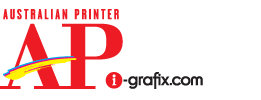Sydney large format printer Next Printing has purchased a Durst Rotex 322 to add to its digital soft signage production line up.
The Rotex 322, supplied by Photo Electric, will be the first in the country when it arrives later this year.
Next began printing directly to fabric for the soft signage market two years ago, and has acquired the Rotex 322 to help expand its growing market share.

Tom Tjanaria (managing director), Romeo Sanuri (general manager), and Julian Lowe (fabric division and marketing manager), with the Durst Rotex 322
Julian Lowe, fabric division and marketing manager with Next Printing, says, “The Durst will allow us to run more unattended hours, thus increasing our capacity overall. It also has better colour gamut, clarity, crispness and print overall, so we think we will be able to colonise more business and market share.
“In this market, if you can do it in the timeframe you’re going to get work. This machine gives us the capacity to react quickly.
“We started with an investment in two direct-to-fabric 3.2m-wide machines two years ago, and one hybrid UV roll-to-roll machine that could also print on fabric. We have seen tremendous growth in that division, so we need to increase our capacity, where we don’t necessarily have the space to increase our size.”
Tom Tjanaria, managing director with Next Printing, says the company was the first in the Asia Pacific to purchase a Durst Rho P10 250 flatbed roll-to-roll hybrid last year, and Next is now following this up in 2013 by becoming the first in the Asia Pacific to own the new generation Rotex 322.
Lowe says the company is happy to stay with the Italian manufacturer. He tells Australian Printer, “Durst machines are designed for industrial applications, so they have a reliability, a solidity, so they can keep working unattended. Their systems and platforms work across all the machines and we have had great success with them – better to stay with what we know and what works well.”
Lowe adds that there are advantages to choosing fabric signage over board. He says, “There is still a lot of space to grow fabric signage. Why does a customer chose fabric over other substrates? Predominately ease of transport and installation – it is easier to shift a folded piece of fabric in a flatpack frame than it is to send a 2.4m-wide board. The possibility of damage in transportation, the insurance involved, there is a lot more risk. Fabric just makes more sense. So everyone who is using a board or any kind of solid substrate is a target market that can be colonised.”
“The biggest growth in fabric has been in stretch frames; frames with a silicon welt that goes into an aluminium frame. These are used in point of sale, in trade shows and exhibitions. That style of signage has really blossomed in the retail and exhibition markets.”
Next Printing started out as a photography developer 28 years ago, branching out into high-end photographic development which it still offers today. The company has 46 staff across its two sites in Sydney, offering services primarily in retail, exhibition, fabric and re-board.
Greg Fereday, NSW state manager with Photo Electric, says, “The Durst soft signage printers are industrial scale solutions that will perform day in day out to produce top quality work. Soft signage is a major growth market, and is just beginning, so opportunities are there.”
GO TO MORE AUSTRALIA NEWS
 i-grafix.com | Print News | Packaging News | Wide Format news | Australia, New Zealand and Asia Print and Packaging news from Australia, New Zealand and Asia
i-grafix.com | Print News | Packaging News | Wide Format news | Australia, New Zealand and Asia Print and Packaging news from Australia, New Zealand and Asia


